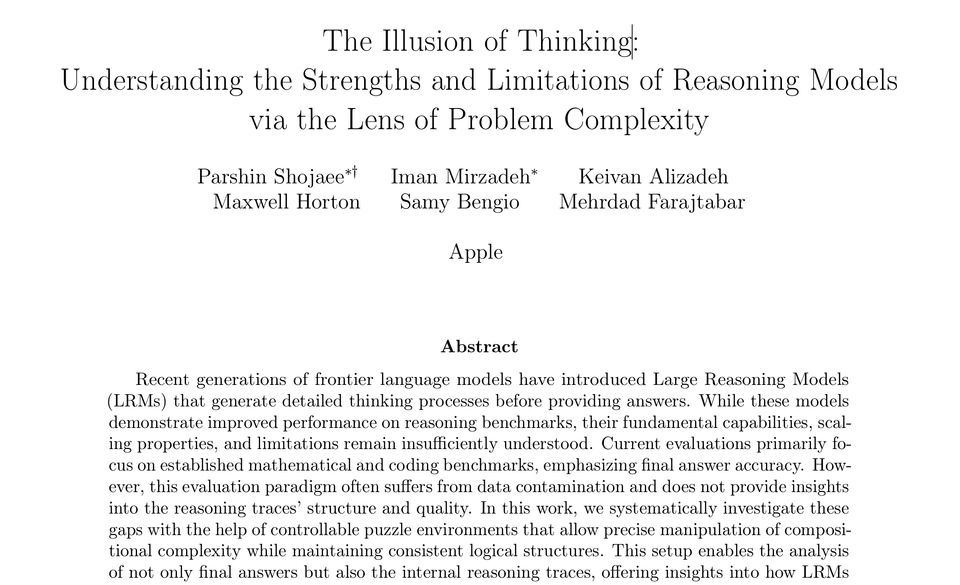The Illusion of Thinking: What Apple’s Paper Really Says About "Reasoning" Models

A recent paper from Apple, titled "The Illusion of Thinking: Understanding the Strengths and Limitations of Reasoning Models via the Lens of Problem Complexity", made a ruckus in parts of the machine learning community. Although the paper has a provocative title and a strong research foundation, some have misinterpreted its findings as evidence that reasoning in Large Language Models (LLMs) is fundamentally flawed—or even an illusion.
But let’s step back and take a breath. As someone who's spent years around machine learning systems, both in academia and industry, I see this paper not as a takedown—but a timely reality check. And frankly, it’s one we need.
Let me unpack the key contributions of the paper, one by one, with my perspective added in.
What Is "Thinking" in LRMs, Really?
To understand the paper, we need to demystify what "thinking" actually is in a Large Reasoning Model (LRM).
In essence, "thinking" in current models is just an extended chain of generated words—tokens—based on prior tokens. These models are autoregressive, meaning each new word is predicted based on the previous ones. The assumption is: if you let them "think" (i.e., generate a longer sequence of intermediate reasoning steps), they’ll catch and correct earlier mistakes—improving the final answer.
But here’s the catch: this "thinking" is not grounded in logic trees or symbolic math. It’s grounded in word prediction—no more, no less. You can think of it like a Retrieval-Augmented Generator (RAG): sometimes the retrieved context is helpful, sometimes it’s not. Sometimes the model starts in the wrong place. Sometimes it doesn’t correct itself. And that’s where generalization and accuracy start to fall apart—just like in any other supervised learning system.
Machine Learning’s Core: Generalization
If I had to boil the essence of machine learning into two words, they’d be: generalization performance.
That is, how well does a model perform on unseen data based on what it learned from seen data?
In traditional supervised learning, we draw a clear line between training and test data. But in LLMs, with web-scale training and opaque datasets, that line got blurry. For too long, we’ve relied on benchmarks that might have contaminated test sets or cherry-picked problems.
This paper helps correct that trajectory by asking: are these models really reasoning—or are they just repeating?
1. Rethinking the Evaluation Paradigm
Apple’s Contribution: The authors criticize current math benchmark evaluations and introduce a controlled experimental testbed using algorithmic puzzle environments where they can tune problem complexity.
My Take: Yes—absolutely the right step. We’ve relied too long on benchmarks without really knowing what we’re testing. If you want to measure reasoning and generalization, you need controlled, synthetic environments where the structure stays constant but the difficulty grows. This is much more like what machine learning research should look like.
2. Accuracy Collapses Beyond Complexity Thresholds
Apple’s Contribution: Leading LRMs like DeepSeek, Claude-3.7, and OpenAI’s o3-mini break down at higher complexity levels, showing a total collapse in accuracy.
My Take: Not surprising—and again, very important to highlight. These models are not general-purpose problem solvers. Their performance drops because the reasoning process they simulate via text prediction is unstable beyond a certain level. The issue isn’t necessarily architecture—it’s how we train and evaluate these systems.
This is the same problem we see in other areas of AI: hallucinations, brittle logic, and overfitting. It’s not proof of failure—it’s a sign we need better constraints and signals during training.
3. The Counterintuitive "Scaling Limit" in Thinking Tokens
Apple’s Contribution: After a certain complexity threshold, models don’t think harder—they think less. The number of “thinking tokens” actually drops as complexity increases.
My Take: This is where recall and search strategy limitations surface. The model fails to engage enough depth in the problem—it likely picks a bad initial trajectory and never corrects course. This is deeply tied to the autoregressive nature of these systems: they can’t backtrack, and often don’t recover once they drift.
4. Evaluating the Thinking Process, Not Just the Final Answer
Apple’s Contribution: Instead of only judging accuracy, the authors analyze intermediate reasoning steps using deterministic puzzle simulators, uncovering when correct solutions appear and how often.
My Take: Finally! This is the sort of explainability and trace-level analysis we desperately need. Much like how you wouldn’t just grade a student’s final answer but also their thought process, evaluating "reasoning traces" reveals how the model gets there—and where it goes wrong.
This is a model for future research: go beyond final outputs. Understand trajectory, divergence, and self-correction.
5. Inability to Execute Explicit Algorithms
Apple’s Contribution: Even when given explicit algorithms or clear instructions, LRMs fail to execute them consistently, especially across puzzle types.
My Take: This is a deeper concern—and one we’ve seen elsewhere. These models lack algorithmic fidelity. They do not "run code in their heads"; they simulate reasoning through word patterns. They might get the shape of the solution right, but not the logic or consistency.
It reinforces that today's LLMs are statistical engines, not symbolic processors. Without true grounding or execution logic, they’re limited to approximations—sometimes excellent, sometimes fragile.
Final Thoughts: Let’s Get Real About Generalization
This paper doesn’t "expose" LLMs as failures. It reminds us of what machine learning is really about: building models that generalize to unseen, harder problems—not just regurgitating what they’ve seen.
It’s a warning against the misuse of the AGI label, which has too often been deployed to hype valuations and inflate expectations. Training large models on massive word corpora does not magically create reasoning. That still requires structure, guidance, and principled evaluation.
We shouldn’t be surprised that hallucinations persist or that reasoning collapses with complexity. We’ve always known: generalization doesn’t come for free.
This paper isn’t controversial. It’s necessary. It brings the community back to solid ground. It questions hype with rigor. And it gives us better tools to ask the right questions.
And that’s how real progress begins.
